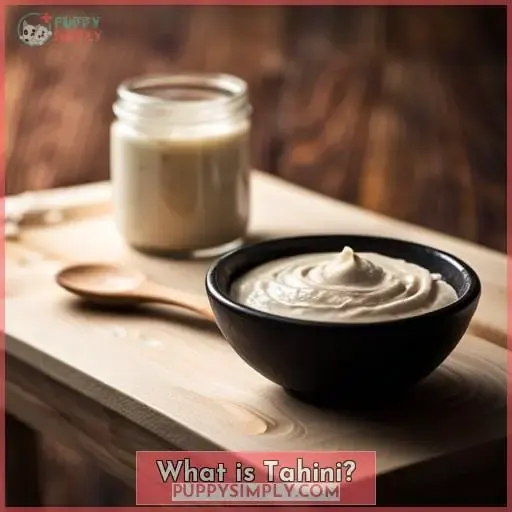This site is supported by our readers. We may earn a commission, at no cost to you, if you purchase through links.

It’s often used as a topping for hummus, falafel, or salads. But what are the risks associated with giving this tasty treat to dogs? Can Dogs Eat Tahini? Benefits, Risks & Tips will look at whether tahini is safe for your pup and how you should go about feeding it.
Table Of Contents
Key Takeaways
- Tahini paste can be given to dogs in small amounts as an occasional homemade treat.
- Store-bought tahini should be avoided due to its high salt content.
- Dogs with sesame seed allergies can be given tahini made from peanuts as a substitute.
- Controlling portion sizes and fat intake is important to prevent weight gain and obesity in dogs.
Is Tahini Safe for Dogs?
You may have heard of the many health benefits tahini offers humans, but is it safe for dogs to eat? Before introducing this nutritional powerhouse into your pup’s diet, it’s important to consider potential risks like vomiting and diarrhea, weight gain or obesity due to its high fat content, and even a sesame seed allergy.
Keep reading as we delve deeper into these considerations so you can make an informed decision about whether tahini is right for your furry companion.
Vomiting and Diarrhea
Too much tahini can lead to unpleasant reactions in your furry friend, such as vomiting and diarrhea. Store-bought tahini is often too salty for dogs, whereas homemade versions should be made without salt.
Allergic reactions and other harmful effects are possible if dietary changes occur suddenly or if large amounts of fatty acids are consumed.
Homemade tahini with no added salt may reduce the risk of digestive issues, but it should still only be given as an occasional treat – not a regular part of their diet! Sesame seeds provide excellent nutrition when used sparingly, so consider supplementing your pup’s meals with small amounts rather than overfeeding them on store-bought or homemade treats.
Weight Gain and Obesity
Consuming too much tahini can cause weight gain and obesity in your pet. With its high fat content, even small amounts of the grain-free seed paste can add up to a lot of extra calories that could lead to increased body mass.
It is important to watch portion sizes when feeding tahini – just like with any other food.
Dietary changes may be necessary if you want your pet to lose weight. Reducing overall fat intake is an essential part of this process, as well as controlling portions and replacing some meals with healthy alternatives low in fatty foods such as fresh fruits or vegetables.
Although it’s not recommended for regular consumption, occasional treats made from homemade tahini without added salt are acceptable if monitored closely by owners who carefully consider their dog’s individual needs regarding caloric intake and dietary restrictions.
Sesame Seed Allergy
Be aware that sesame seed allergies can occur in some dogs, so always consult your vet before feeding tahini to your pup. Dogs with food allergies may experience digestive issues or show symptoms such as vomiting and diarrhea after consuming the paste.
The oil content of tahini might also contribute to weight gain or obesity in certain pups, depending on their individual metabolism.
While it does contain many essential nutrients like calcium and iron, its salt content should be taken into account when deciding how much is safe for a dog’s diet. If you decide to give them tahini as an occasional treat, make sure it has no added ingredients like hummus, which could lead to further health complications due to dietary restrictions specific breeds have.
What is Tahini?
Tahini is a nutty, earthy condiment made from ground sesame seeds and oil that has many health benefits when enjoyed in moderation. It’s an excellent source of fatty acids, protein, fiber, vitamins, and minerals, including calcium, iron, and zinc.
Tahini also contains vitamin B to boost brain function and regulate metabolism while providing a gluten-free option for dogs with sensitivity to wheat or grains.
The risks associated with tahini include vomiting, diarrhea, or weight gain if too much is consumed due to its high fat content, which can be bad for dogs’ sensitive stomachs. Store-bought varieties are often high in salt, so it’s best to prepare homemade tahini using just roasted sesame seeds blended with olive oil (omitting the salt).
When giving tahini treats to your pup, remember moderation is key. Only give small amounts at first until you’re sure there won’t be any adverse reactions like an upset stomach or digestive distress before introducing larger doses into their diet slowly over time.
Important Considerations When Feeding Tahini to a Dog
It’s important to consider the steps involved when feeding tahini to a dog. To make the most of this nutritious treat, start by toasting sesame seeds until they are lightly browned and fragrant. Then, grind them into a crumbly texture before adding oil and blending it all together until you have a smooth cream.
Step 1: Toast the Sesame Seeds
Toast the sesame seeds in a dry skillet over medium heat, stirring often, until golden brown and fragrant. This toasting method will bring out flavor profiles while preserving nutrient content.
Use small amounts when serving to dogs as excess fat and calories can lead to health problems like weight gain or heart disease.
Serve it occasionally as an enriching treat for balanced carbohydrate metabolism and brain function benefits without risking vomiting or diarrhea from too much salt found in store-bought options.
Moderation is key when introducing new foods into your pet’s diet!
Step 2: Grind Sesame Seeds Until Crumbly
Once the sesame seeds have been toasted, grind them in a food processor or blender until they become crumbly. This is an important step when making tahini as it will affect the texture and nutritional value of your end product.
Here are some key points to consider:
- Dietary moderation for dogs is essential, especially with high-fat content foods like tahini.
- Blending oil with rapeseed oil can help improve flavor while providing essential fatty acids.
- Toasting the seeds not only adds a nutty flavor but also improves digestibility and reduces allergy risk.
- Can dogs eat tahini? Yes, but do so sparingly as too much may cause digestive issues for your pup!
Step 3: Add Oil and Blend Into a Smooth Cream
Once the sesame seeds are crumbly, add some oil and blend until you have a smooth, creamy tahini paste. When handling the oil for your tahini, make sure to use just enough so it reaches an ideal cream consistency without becoming too runny or thick.
This will ensure that your final product has a great flavor balance and freshness factor, which is important when feeding this food to dogs as a treat.
It’s also important to practice portion control, so be sure not to overdo it with the amount of oil used in order not to give them too much fat at once!
Can Dogs Eat Tahini Paste?
Moving on from Important Considerations When Feeding Tahini to a Dog, it’s important to consider if dogs can eat tahini paste. The short answer is yes – in moderation and when prepared properly. Store-bought tahini should be avoided due to its high salt content, which can be detrimental for your pup’s health.
Furthermore, you must take into account any allergies before feeding your dog any kind of food like sesame or even homemade tahini paste made with roasted sesame seeds and oil. The fatty acids found in this treat make it an excellent nutritional supplement, as long as they are not consumed too often because of their high-fat diet potentials that could lead to weight gain.
If you decide that homemade tahini is what’s best for your pup after consulting with a veterinarian, then substitute ingredients such as peanuts instead of sesame seeds while omitting salt entirely.
Can Dogs Eat Sesame Seed Butter?
Sesame seed butter is a tasty treat that can offer your pup a nutritious boost, while providing them with plenty of health benefits. From regulating metabolism to aiding in digestion and improving cholesterol levels, this delicious snack has much to offer.
Here are three ways sesame seed butter can help keep your dog healthy:
Serving size – A small amount of sesame seed butter goes a long way when it comes to offering nutritional value for dogs. Start by giving only one teaspoon per day and adjust accordingly based on their individual needs.
Olive oil – To make homemade tahini paste or sesame seed butter for dogs, mix together raw seeds with olive oil until you achieve the desired consistency. Be sure not to add any salt!
Health Benefits – Not only does it provide an excellent source of fatty acids, protein, fiber, vitamins, and minerals like calcium, iron, and zinc, but it also helps reduce inflammation as well as improve heart health. Just be careful not to give too much at once since high-fat human foods may cause vomiting, diarrhea, weight gain, or obesity in some cases if given in excess amounts or more often than necessary. Raw seeds may also trigger food allergies, so always check with your vet first before introducing anything new into their diet!
Frequently Asked Questions (FAQs)
How much tahini should I give my dog?
Give your dog only small amounts of tahini, as too much can be unhealthy. Moderation is key; just a pinch adds flavor and nutrition to their meals! Serve it in moderation for an occasional treat, but don’t rely on it as part of their regular diet.
Are there any health risks associated with feeding tahini to my dog?
Feeding tahini to your dog may have health risks such as vomiting, diarrhea, and weight gain. Store-bought versions are often high in salt, which is bad for dogs, so moderation is key when giving high-fat human foods.
Make sure to give small amounts at first and monitor any adverse reactions before increasing portions.
Is tahini a complete source of nutrition for my dog?
No, tahini is not a complete source of nutrition for your dog. It contains vitamins, minerals, and fatty acids but should only be an occasional treat due to its high fat and calorie content. Moderation is key when feeding high-fat human foods to dogs – give small amounts initially to test for adverse reactions.
Is there a difference between sesame seed butter and tahini?
Yes, there is a difference. Sesame seed butter is made from hulled sesame seeds and oil; tahini uses the whole sesame seed with added ingredients like salt or lemon juice. Both are nutty and flavorful, but tahini has more calcium, iron, and zinc than just plain sesame seed butter.
Are there any other ways I can serve tahini to my dog?
Want to give your pup a nutritious snack? Why not try tahini! It’s packed with beneficial fatty acids, protein, and fiber. Serve it in moderation though – too much can cause vomiting or weight gain. You can add small amounts to meals or treats for a tasty boost.
Conclusion
In summary, although there are some benefits to feeding tahini to dogs, it’s important to do so in moderation. A staggering 80% of dogs that are overweight or obese are due to their diets. Thus, it’s important to keep an eye on how much tahini your pup consumes.
Tahini is a paste made from hulled, ground sesame seeds and oil, and can be made at home without the addition of salt. It’s high in fat, calories, and essential minerals such as iron and zinc. If you choose to feed tahini to your pup, start with small amounts and monitor for any adverse reactions.
As a general rule, tahini shouldn’t be a regular part of your pup’s diet, but an occasional treat.











